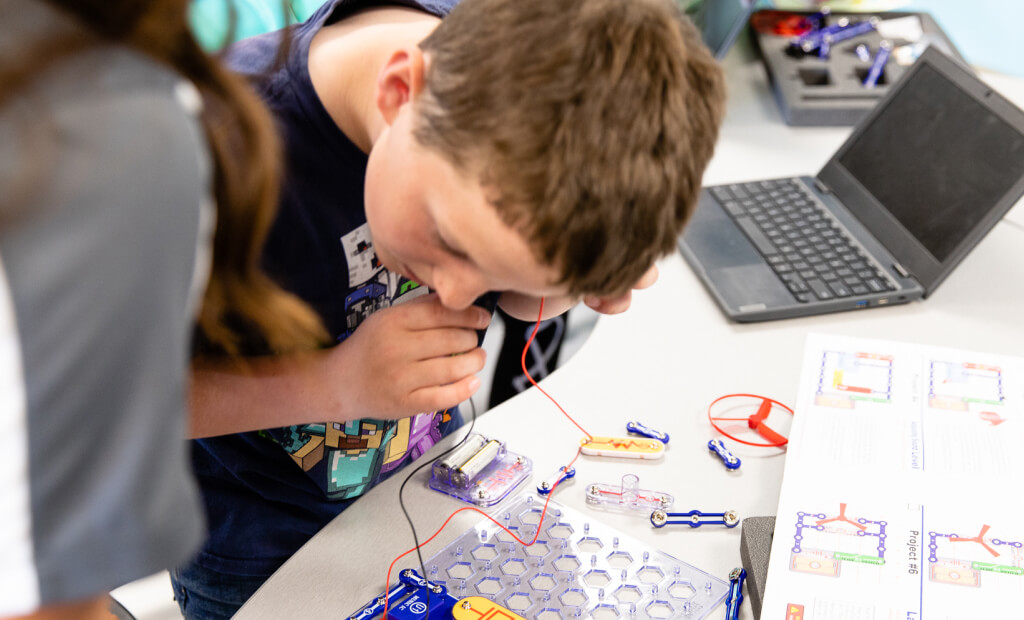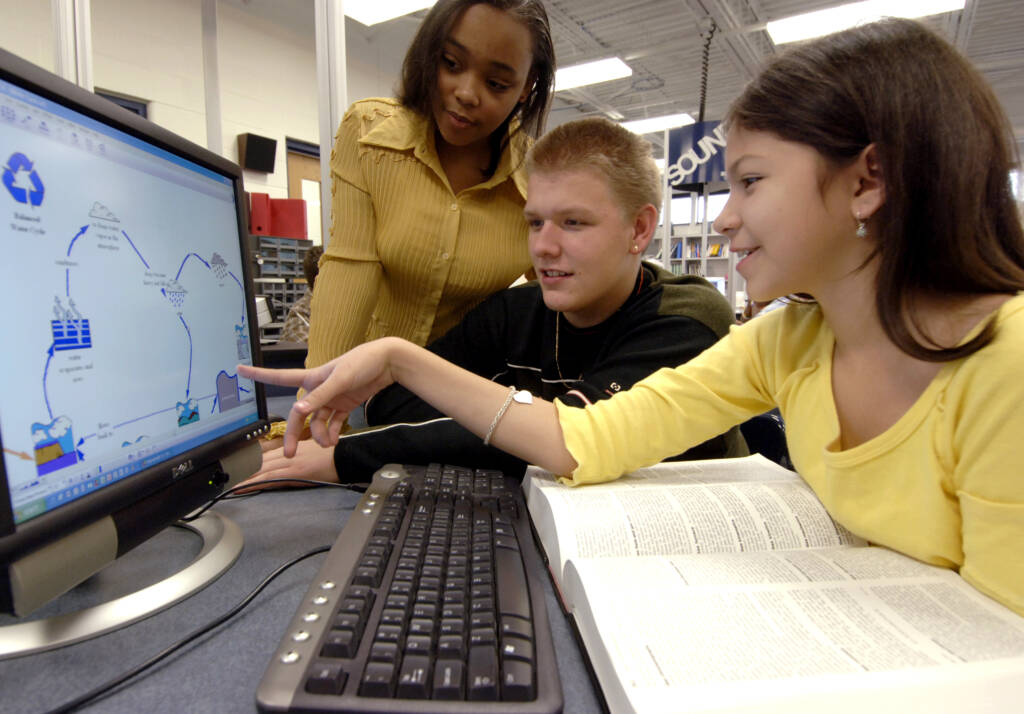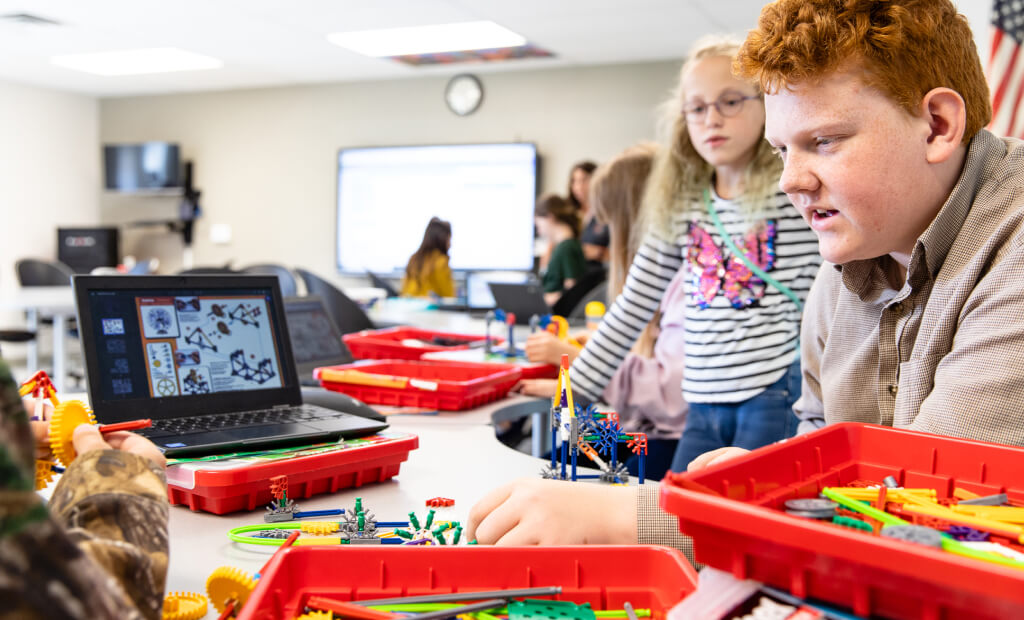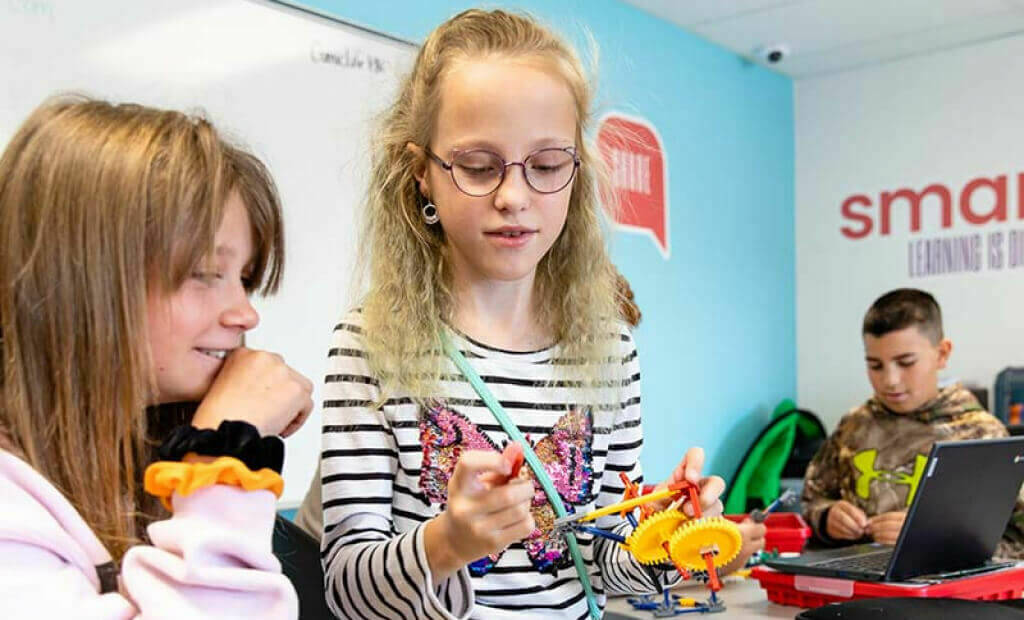Electronic and Digital Literacy in Education
From the future of work to the communication and commodification of private data, digital technology now impacts every aspect of our lives. In an increasingly digital world, digital literacy is becoming just as important as traditional literacy. While young learners may be comfortable using technology, they are not inherently equipped with the skills to protect themselves or understand best practices.
Even if your school does not offer a dedicated digital literacy course, lessons and activities can be seamlessly integrated into the broader curriculum in engaging and relevant ways.
What Is Digital Literacy?
Digital literacy encompasses the knowledge, skills, and attitudes necessary to navigate and engage effectively in our increasingly digital world. Initially, it referred to the ability to use information and communication technologies (ICT) to find, evaluate, use, and communicate information online. However, as technology has evolved, so has the scope of digital literacy.
Today, the meaning of digital literacy has expanded beyond basic internet use to include understanding and actively engaging with advanced technologies in our everyday lives — including facial recognition, AI automation, social media, and digital profiling. It involves not only technical proficiency but also the capacity to critically assess digital content, create and share information responsibly, and maintain personal safety and well-being in digital environments.
The UNESCO Institute for Statistics defines digital literacy as “the confident and critical use of a full range of digital technologies for information, communication and basic problem-solving in all aspects of life. It is underpinned by basic skills in ICT: the use of computers to retrieve, assess, store, produce, present and exchange information, and to communicate and participate in collaborative networks via the Internet.”
Digital literacy equips individuals to be both safe and empowered in a digital world, enabling them to participate fully and responsibly in society.
Why Is Digital Literacy Important for Kids?

Children increasingly rely on digital technologies for play, socialization, research, and learning. While digital tools offer countless opportunities, they also come with risks—such as unreliable information, privacy concerns, and online safety threats. Digital literacy initiatives help to ensure that students can navigate the online world safely, responsibly, and effectively by:
- Ensuring Online Safety and Promoting Reliable Information
Not all content online is safe or trustworthy. Digital literacy teaches students how to evaluate sources critically, recognize misinformation, and protect themselves from online risks, such as cyberbullying, scams, and data privacy breaches. A strong foundation in digital literacy helps children make informed decisions about the content they consume and share. - Bridging the Digital Divide
Many students lack access to the digital tools and skills necessary to fully participate in today’s technology-driven world. This “digital divide” creates disparities in educational and career opportunities. Digital literacy education ensures that all students, regardless of background, have access to resources and the knowledge they need to succeed in an increasingly digital society. - Preparing Students for Future Careers
The workforce of tomorrow will require both technical and soft skills. Employers increasingly seek workers who can use digital toolseffectively, analyze information, and collaborate online. Digital literacy helps students develop problem-solving abilities, creativity, and adaptability—skills that are crucial for success not just in academic settings and future careers, but also in their daily lives. - Promoting Responsible Digital Citizenship
Beyond technical skills, digital literacy fosters ethical online behavior and responsible digital citizenship. It teaches learners how to engage respectfully in digital spaces, communicate effectively, and collaborate with others while considering cultural and generational differences. These 21st-century skills are essential in both personal and professional environments. - Teaching Lifelong Learning and Adaptability Skills
As technology continues to evolve, digital literacy prepares students to be lifelong learners. Whether it’s adapting to new platforms, staying informed about digital trends, or learning new skills, digital literacy ensures that learners remain flexible and ready for the demands of an ever-changing world.
Key Digital Literacy Skills for Kids
Students need to learn how to use computers and other digital tools, how to search for information and protect themselves while online, and how to apply the skills they learn in real-world contexts. The European Union outlines five competence areas for digital literacy in its Digital Competence Framework for Citizens (DigComp):
- Information and Data Literacy: Helping learners recognize what information they need, find and access digital resources, and evaluate the reliability and relevance of sources. Teaching them how to store, organize, and manage digital information effectively.
- Communication and Collaboration: Guiding learners in using digital tools to communicate and work together while respecting cultural and generational differences. Encouraging responsible participation in digital communities, both public and private, and helping learners manage their online identity and reputation.
- Digital Content Creation: Supporting learners in creating and editing digital content while integrating information responsibly and ethically. Teaching them about copyright, licenses, and how to provide clear instructions for computer systems, such as coding or automation.
- Safety and Privacy: Educating learners on how to protect their devices, personal data, and privacy in digital spaces. Promoting digital well-being by addressing online safety, mental and physical health, and the responsible use of technology. Raising awareness about the environmental impact of digital tools and encouraging sustainable practices.
- Problem Solving and Critical Thinking: Helping learners develop critical thinking skills to identify and solve challenges in digital environments. Encouraging innovation by using technology to improve processes and create new solutions. Providing them with the skills to stay informed about technological advancements.
There are important parallels between data literacy and digital literacy. Learn more about key data literacy skills and actions that educators, administrators, and districts can take to inform learners in Data Literacy for Young Learners: Preparing Students for a Data-Driven World.
While digital literacy is essential for student success, several challenges make it difficult for educators to effectively integrate it into the curriculum. According to UNICEF, the major barriers to teaching digital literacy include:
- Lack of Teachers’ and Trainers’ Capacity — A lack of expertise makes it difficult to confidently teach students about online safety, responsible digital citizenship, and the ethical use of digital resources. Schools often lack ongoing training programs to help teachers stay updated with technology, and they may lack the pedagogical strategies to integrate digital literacy effectively into lessons.
- Lack of ICT Infrastructure — A lack of essential technology can significantly hinder digital literacy education, as schools do not have enough computers, tablets, or other digital tools for students to engage in hands-on learning. Even when technology is available, limited IT staff or budget constraints can make it difficult to maintain hardware, update software, or troubleshoot issues.
- Low Connectivity — Access to reliable internet is a major barrier for schools in rural and underserved communities. Many schools, particularly in lower-income communities, struggle to afford high-speed internet or necessary data packages. Even when internet access is available, slow speeds can make digital activities frustrating or impractical.
- Lack of Understanding from Decision-makers — A lack of awareness or prioritization from policymakers, school administrators, and other key decision-makers can further complicate these other challenges. If decision-makers view digital literacy as an optional skill instead of important competency, then educators will lack proper support.
One of UNICEF’s recommendations for overcoming these barriers is that digital literacy programs should be context-driven. Incorporating data literacy throughout a school’s courses and curriculum can not only lower some of these barriers but also make instruction more engaging for learners. Consider the following approaches as learning objectives.
Education Programs to Teach Digital Literacy
The following recommendations align with the ISTE Standards for being a Digital Citizen, from showing students how to manage their digital identity and online interactions to safeguarding their well-being and protecting their privacy. All of the example activities are based on actual lessons from the SmartLab curriculum.
How to Use Digital Technology
Carefully and intentionally use mobile devices and apps as part of the curriculum. Research has shown that educational screen time can positively impact children’s persistence and cognitive skills, benefiting their overall learning outcomes. However, excessive screen use has also been linked to impaired social-emotional development, difficulties in emotional comprehension, and negative effects on cognitive growth.
According to the American Academy of Child & Adolescent Psychiatry, children ages 8-12 in the U.S. already spend an average of 4-6 hours per day watching or using screens, while teens spend up to 9 hours. The Modern Classrooms Project recommends using short, focused screen time, where students watch videos of less than eight minutes, followed by engaging, collaborative, and interactive learning activities.
To instruct learners in the use of digital technology, these activities can involve:
- Data Privacy and Security: Instruct students on creating strong passwords, understanding privacy settings, and recognizing phishing attempts. Emphasize the importance of protecting personal information online.
- Digital Footprint Management: Help students understand that their online actions leave a lasting trace. Encourage thoughtful posting and sharing, highlighting how their digital footprint can impact others and future opportunities.
- Parental Involvement: Engage parents by providing resources and guidance on supporting their children’s digital citizenship at home, creating a consistent message between school and home environments.
Sample activity — Students analyze how well-known brands use digital technology to shape industries, market products, and engage consumers. They will also develop a mock marketing strategy using digital tools while emphasizing ethical and responsible practices in digital media.
- Learning Outcomes:
- Understand how digital media influences branding, marketing, and sales
- Evaluate ethical considerations in digital marketing
- Develop a responsible digital strategy for promoting a product
- Improve research, collaboration, and communication skills
- Students get into groups and then:
- Explore how successful brands use digital technology in marketing, sales, and customer engagement
- Share their findings, discussing effective strategies and ethical concerns
- Develop a digital marketing campaign for a fictional or real product using ethical and responsible practices
- Present their strategies to the class
How to Use Online Resources
Teach students how to conduct thorough online searches and use digital sources ethically. While the quantity of online content has increased dramatically, its quality has not necessarily improved. Misinformation and disinformation are on the rise—according to the American Psychological Association (APA), they can account for up to 29% of overall news consumption. This makes the ability to assess a source’s legitimacy more critical than ever.
To counter misinformation and ensure accuracy, experts recommend repeatedly leveraging trusted sources. Digital literacy specialists also advocate for the SIFT method, which helps students evaluate online information:
- Stop — Pause before trusting a source
- Investigate the source — Research the publisher or author
- Find better coverage — Compare multiple credible sources
- Trace claims to the original context —–Verify facts at the source
Additionally, learners should understand safe social media practices, how to properly credit creators, and their rights and responsibilities when sharing content. A key aspect of digital literacy is knowing how to use and share intellectual property legally and ethically.
Sample activity — Students take on professional roles (instructional designers, UX designers, software engineers, and quality assurance engineers) to create a mobile learning app for their school. They will practice evaluating and selecting credible online resources to develop accurate and engaging educational content.
- Learning Outcomes:
- Identify and evaluate reliable online sources for educational content
- Understand how to legally and ethically use digital media, data, and resources
- Develop an engaging and user-friendly mobile learning experience
- Collaborate effectively in a team setting to design a digital product
- Students get into groups and then:
- Choose an educational topic or skill for their app (e.g., math practice, language learning, digital literacy, historical trivia)
- Conduct online research to gather educational content, media, and interactive elements for their app
- Identify digital media resources (videos, images, interactive elements) that are legally available for use (e.g., Creative Commons, Open Educational Resources).
- Use tools such as Canva, Figma, Google Slides, or MIT App Inventor to create a visual mockup of their app, showing how users interact with the content
- Present their app concept, content sources, and design choices to the class
How to Be a Digital Citizen
Integrate digital citizenship and online safety into instruction. Promote respectful communication and educate students about appropriate online behavior and the importance of empathy in digital interactions. Encourage students to share their thoughts and experiences to help them understand that their online activities and behavior have lasting impacts.
Critical thinking exercises should include recognizing when algorithms manipulate content or when microtransactions target users. According to the APA, young people are particularly vulnerable to AI-recommended content and personalized ads because they are highly sensitive to social feedback and stimuli. Young learners also have a harder time resisting impulses and considering long-term consequences, making it more difficult for them to disengage from social media.
Offering activities where learners are able to recognize and discuss these vulnerabilities can help them protect their privacy, their information, and their mental health.
Sample activity — Students will design a “Cooldown Chatbot”—a digital tool to help peers regulate emotions, manage stress, and maintain focus in the classroom. This activity will teach them how technology can support well-being, foster responsible digital citizenship, and promote ethical AI use in everyday life.
- Learning Outcomes:
- Understand the role of digital tools in promoting mental well-being
- Develop responsible and ethical digital citizenship practices
- Explore how AI and chatbot technology can provide personalized support
- Improve problem-solving, collaboration, and design-thinking skills
- Students get into groups and then:
- Discuss digital citizenship and how technology impacts mental health, including how AI-powered tools can help manage stress and emotions
- Research AI chatbots and how they are used in mental health and customer service
- Use flowchart tools (e.g., Google Drawings, Canva, Lucidchart) to map out chatbot responses
- Use no-code chatbot platforms such as Scratch to create a simple prototype
- Test their chatbots by role-playing as users and then explain how it promotes well-being
How to Interact with Others
Students need to know how to interact with others responsibly to ensure they can navigate the online world safely, ethically, and effectively. Without proper guidance, they may unknowingly engage in harmful behaviors such as cyberbullying, misinformation sharing, or inappropriate communication. Students must also navigate interactions with people from diverse backgrounds and perspectives while avoiding discrimination and harmful stereotypes in digital conversations and content creation.
Modern workplaces rely heavily on digital collaboration tools such as email, project management software, and video conferencing. Without digital literacy and social interaction skills, students may struggle to communicate and collaborate effectively. Educators can prepare students for the workforce by integrating real-world digital communication skills into their learning experiences. Educators can also model behavior by regularly collaborating online with other schools and educators.
Sample activity — Students will explore circuitry and electronics to design and build unique digital communication tools, such as LED message boards, Morse code buzzers, or simple chat devices. This hands-on activity will teach them about ethical and responsible digital interaction while fostering creativity and teamwork.
- Learning Outcomes:
- Understand how communication technologies work through hands-on design
- Develop awareness of safe, legal, and ethical digital communication
- Learn collaboration and responsible online interaction through project teamwork
- Apply problem-solving and engineering skills to build a functional communication device
- Students get into groups and then:
- Discuss the importance of digital communication and explore examples of communication tools (social media, messaging apps, chatbots, etc.)
- Choose a circuit-based communication tool to create, sketch a design plan, and map out how their device will work and its intended purpose
- Build their chosen tool and then test and troubleshoot to ensure functionality
- Presents their tool and explains how it fosters safe, ethical communication
Looking for more details on digital literacy? PBS Learning Media has several video resources on digital literacy, including fact-checking guides and how to recognize misinformation.
Conclusion
Digital literacy will only increase in importance as more aspects of young learners’ lives become digital. From their social interactions and entertainment, to their careers, finances, and how they engage with their community—good digital literacy is essential to safety and engagement in the 21st-century.
Integrating data literacy into your school’s curriculum doesn’t require a specialized course, instead it can be more effective—and economical—to align digital literacy skills with other educational goals. For example, you could:
- Have students conduct research projects online, but show them how to recognize reliable sources from unreliable ones, and ask them to explain their selection.
- Ask students to collaborate online over a project, but ask them first to draft a “code of conduct” that all members of a group will adhere to when working together—both online and in class.
- Share digital tools and resources with students for projects and require that they explore self-assistance features such as FAQs or chatbots to teach themselves how to use certain features.
SmartLabs are designed to help kids understand digital tools by integrating them directly into projects and lessons, helping learners build digital literacy from an early age. These spaces enable more personalized approaches to student-directed learning so students can explore different concepts, issues, problems, and relationships that can relate to their own interests or community.
FAQs
What is digital literacy?
Digital literacy is the ability to safely, effectively, and critically navigate, evaluate, and create content using digital technologies. It includes online safety, responsible communication, information evaluation, and ethical digital citizenship. In an evolving digital world, it equips individuals with essential skills for learning, work, and everyday life.
Why is digital literacy important for kids?
Digital literacy is crucial for kids because it helps them safely navigate the online world, critically evaluate information, and engage responsibly in digital spaces. It equips them with essential skills for future education and careers, fosters ethical online behavior, and ensures they can protect their privacy while making informed decisions in a technology-driven society.
What is the SIFT method for evaluating online resources?
The SIFT method is a digital literacy strategy that helps users evaluate online information. It consists of four steps:
- Stop – Pause before trusting a source.
- Investigate the source – Check who created the content.
- Find better coverage – Look for reputable sources.
- Trace claims to the original context – Verify the accuracy of information.
SIFT helps users detect misinformation and think critically online.



